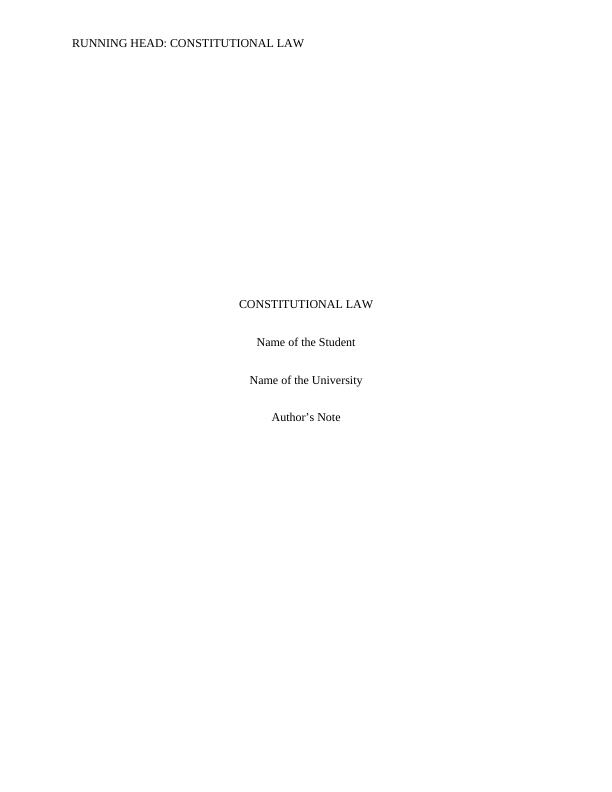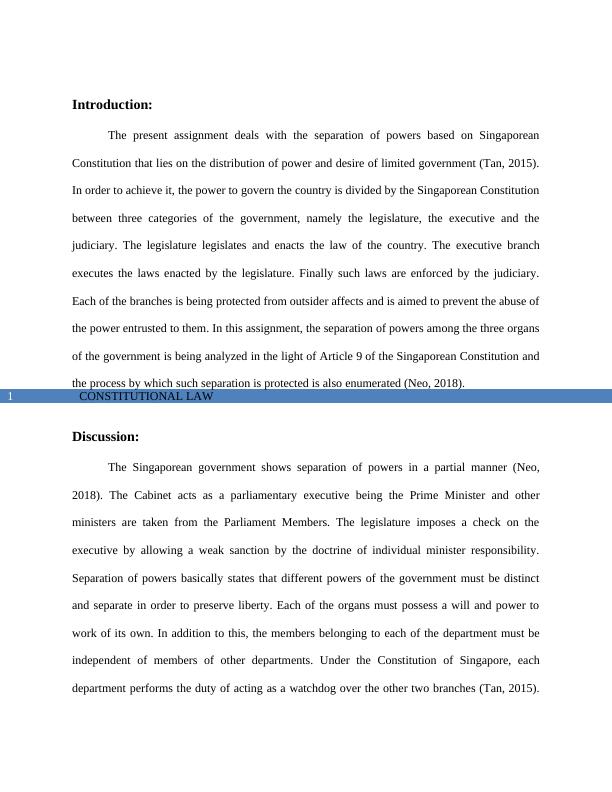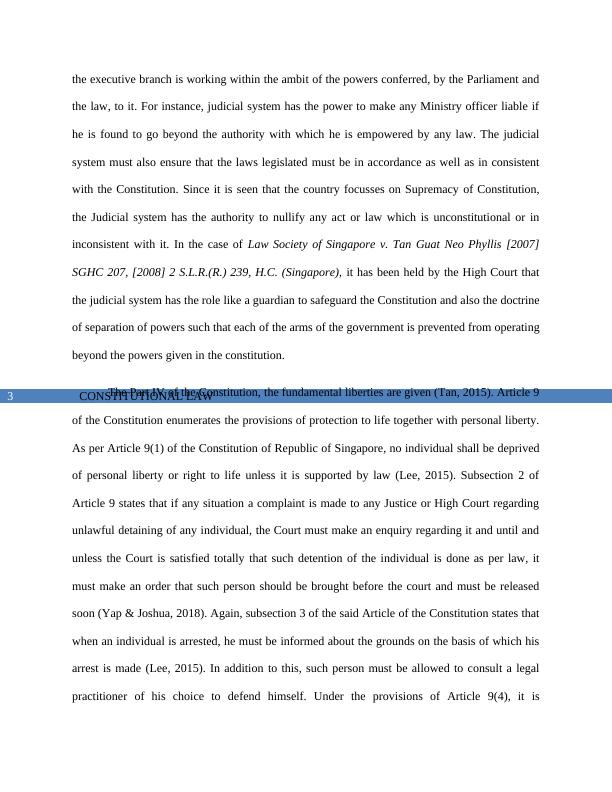Separation of Powers in Singaporean Constitution
11 Pages3322 Words481 Views
Added on 2022-11-24
About This Document
This assignment analyzes the separation of powers in the Singaporean Constitution and the process by which such separation is protected. It discusses the distribution of power among the legislature, executive, and judiciary, and the role of each branch in preventing the abuse of power. The assignment also examines Article 9 of the Constitution, which provides protection to life and personal liberty.
Separation of Powers in Singaporean Constitution
Added on 2022-11-24
ShareRelated Documents
RUNNING HEAD: CONSTITUTIONAL LAW
CONSTITUTIONAL LAW
Name of the Student
Name of the University
Author’s Note
CONSTITUTIONAL LAW
Name of the Student
Name of the University
Author’s Note

CONSTITUTIONAL LAW1
Introduction:
The present assignment deals with the separation of powers based on Singaporean
Constitution that lies on the distribution of power and desire of limited government (Tan, 2015).
In order to achieve it, the power to govern the country is divided by the Singaporean Constitution
between three categories of the government, namely the legislature, the executive and the
judiciary. The legislature legislates and enacts the law of the country. The executive branch
executes the laws enacted by the legislature. Finally such laws are enforced by the judiciary.
Each of the branches is being protected from outsider affects and is aimed to prevent the abuse of
the power entrusted to them. In this assignment, the separation of powers among the three organs
of the government is being analyzed in the light of Article 9 of the Singaporean Constitution and
the process by which such separation is protected is also enumerated (Neo, 2018).
Discussion:
The Singaporean government shows separation of powers in a partial manner (Neo,
2018). The Cabinet acts as a parliamentary executive being the Prime Minister and other
ministers are taken from the Parliament Members. The legislature imposes a check on the
executive by allowing a weak sanction by the doctrine of individual minister responsibility.
Separation of powers basically states that different powers of the government must be distinct
and separate in order to preserve liberty. Each of the organs must possess a will and power to
work of its own. In addition to this, the members belonging to each of the department must be
independent of members of other departments. Under the Constitution of Singapore, each
department performs the duty of acting as a watchdog over the other two branches (Tan, 2015).
Introduction:
The present assignment deals with the separation of powers based on Singaporean
Constitution that lies on the distribution of power and desire of limited government (Tan, 2015).
In order to achieve it, the power to govern the country is divided by the Singaporean Constitution
between three categories of the government, namely the legislature, the executive and the
judiciary. The legislature legislates and enacts the law of the country. The executive branch
executes the laws enacted by the legislature. Finally such laws are enforced by the judiciary.
Each of the branches is being protected from outsider affects and is aimed to prevent the abuse of
the power entrusted to them. In this assignment, the separation of powers among the three organs
of the government is being analyzed in the light of Article 9 of the Singaporean Constitution and
the process by which such separation is protected is also enumerated (Neo, 2018).
Discussion:
The Singaporean government shows separation of powers in a partial manner (Neo,
2018). The Cabinet acts as a parliamentary executive being the Prime Minister and other
ministers are taken from the Parliament Members. The legislature imposes a check on the
executive by allowing a weak sanction by the doctrine of individual minister responsibility.
Separation of powers basically states that different powers of the government must be distinct
and separate in order to preserve liberty. Each of the organs must possess a will and power to
work of its own. In addition to this, the members belonging to each of the department must be
independent of members of other departments. Under the Constitution of Singapore, each
department performs the duty of acting as a watchdog over the other two branches (Tan, 2015).

CONSTITUTIONAL LAW2
The Parliament and the President form the Legislative branch. The Judicial system comprises of
the judges and the Prime minister, President, Cabinet ministers, Police, AGC and the Civil
Service. It is observed that the each branch has the power to act independently without
interfering with the act of other organs. However, each organ has the authority to check the
misuse of power by other branches. In Singapore, as discussed above, there is partial separation
of powers. The legislature and the executives branches overlap as the ministers of the Cabinet are
being appointed by the MPs or the Member of Parliament. Thus it is seen that same class of
people have the authority to make the law as well as to execute the law. The role of guardianship
to look after the appropriate operation of all the branches is entrusted to the judicial system.
Constitution is basically the collection of rules that depict the creation as well as
operation of the government and its organs. In Singapore, the Constitution can be regarded as the
supreme law or the mother of all laws as per Article 4 of the Constitution (Tan, 2015). No law
cannot be enacted which is in contradiction with the Constitution. This is called the
constitutional supremacy. The state requires laws such that it can function properly and as a
result of it, three different powers have been created; one to execute laws. The Constitution of
the country provides the basic framework as well as the fundamental principles of it organs. A
control through checks and balances is formed by means of separation of powers among the
three organs of the government. Though doctrine of separation of power is not discussed in the
Constitution still it can be implied that it had is source in the Constitution only. The power of the
Executive branch lies in the hands of the President whereas the Parliament is entrusted with the
legislative authority. The legislative power is entrusted to the Supreme Courts and other lower
courts and they act as per the legislations in force at that time. The judicial system keeps control
on the Legislature and the Executive. The judicial system is entrusted with the duty to check that
The Parliament and the President form the Legislative branch. The Judicial system comprises of
the judges and the Prime minister, President, Cabinet ministers, Police, AGC and the Civil
Service. It is observed that the each branch has the power to act independently without
interfering with the act of other organs. However, each organ has the authority to check the
misuse of power by other branches. In Singapore, as discussed above, there is partial separation
of powers. The legislature and the executives branches overlap as the ministers of the Cabinet are
being appointed by the MPs or the Member of Parliament. Thus it is seen that same class of
people have the authority to make the law as well as to execute the law. The role of guardianship
to look after the appropriate operation of all the branches is entrusted to the judicial system.
Constitution is basically the collection of rules that depict the creation as well as
operation of the government and its organs. In Singapore, the Constitution can be regarded as the
supreme law or the mother of all laws as per Article 4 of the Constitution (Tan, 2015). No law
cannot be enacted which is in contradiction with the Constitution. This is called the
constitutional supremacy. The state requires laws such that it can function properly and as a
result of it, three different powers have been created; one to execute laws. The Constitution of
the country provides the basic framework as well as the fundamental principles of it organs. A
control through checks and balances is formed by means of separation of powers among the
three organs of the government. Though doctrine of separation of power is not discussed in the
Constitution still it can be implied that it had is source in the Constitution only. The power of the
Executive branch lies in the hands of the President whereas the Parliament is entrusted with the
legislative authority. The legislative power is entrusted to the Supreme Courts and other lower
courts and they act as per the legislations in force at that time. The judicial system keeps control
on the Legislature and the Executive. The judicial system is entrusted with the duty to check that

CONSTITUTIONAL LAW3
the executive branch is working within the ambit of the powers conferred, by the Parliament and
the law, to it. For instance, judicial system has the power to make any Ministry officer liable if
he is found to go beyond the authority with which he is empowered by any law. The judicial
system must also ensure that the laws legislated must be in accordance as well as in consistent
with the Constitution. Since it is seen that the country focusses on Supremacy of Constitution,
the Judicial system has the authority to nullify any act or law which is unconstitutional or in
inconsistent with it. In the case of Law Society of Singapore v. Tan Guat Neo Phyllis [2007]
SGHC 207, [2008] 2 S.L.R.(R.) 239, H.C. (Singapore), it has been held by the High Court that
the judicial system has the role like a guardian to safeguard the Constitution and also the doctrine
of separation of powers such that each of the arms of the government is prevented from operating
beyond the powers given in the constitution.
The Part IV of the Constitution, the fundamental liberties are given (Tan, 2015). Article 9
of the Constitution enumerates the provisions of protection to life together with personal liberty.
As per Article 9(1) of the Constitution of Republic of Singapore, no individual shall be deprived
of personal liberty or right to life unless it is supported by law (Lee, 2015). Subsection 2 of
Article 9 states that if any situation a complaint is made to any Justice or High Court regarding
unlawful detaining of any individual, the Court must make an enquiry regarding it and until and
unless the Court is satisfied totally that such detention of the individual is done as per law, it
must make an order that such person should be brought before the court and must be released
soon (Yap & Joshua, 2018). Again, subsection 3 of the said Article of the Constitution states that
when an individual is arrested, he must be informed about the grounds on the basis of which his
arrest is made (Lee, 2015). In addition to this, such person must be allowed to consult a legal
practitioner of his choice to defend himself. Under the provisions of Article 9(4), it is
the executive branch is working within the ambit of the powers conferred, by the Parliament and
the law, to it. For instance, judicial system has the power to make any Ministry officer liable if
he is found to go beyond the authority with which he is empowered by any law. The judicial
system must also ensure that the laws legislated must be in accordance as well as in consistent
with the Constitution. Since it is seen that the country focusses on Supremacy of Constitution,
the Judicial system has the authority to nullify any act or law which is unconstitutional or in
inconsistent with it. In the case of Law Society of Singapore v. Tan Guat Neo Phyllis [2007]
SGHC 207, [2008] 2 S.L.R.(R.) 239, H.C. (Singapore), it has been held by the High Court that
the judicial system has the role like a guardian to safeguard the Constitution and also the doctrine
of separation of powers such that each of the arms of the government is prevented from operating
beyond the powers given in the constitution.
The Part IV of the Constitution, the fundamental liberties are given (Tan, 2015). Article 9
of the Constitution enumerates the provisions of protection to life together with personal liberty.
As per Article 9(1) of the Constitution of Republic of Singapore, no individual shall be deprived
of personal liberty or right to life unless it is supported by law (Lee, 2015). Subsection 2 of
Article 9 states that if any situation a complaint is made to any Justice or High Court regarding
unlawful detaining of any individual, the Court must make an enquiry regarding it and until and
unless the Court is satisfied totally that such detention of the individual is done as per law, it
must make an order that such person should be brought before the court and must be released
soon (Yap & Joshua, 2018). Again, subsection 3 of the said Article of the Constitution states that
when an individual is arrested, he must be informed about the grounds on the basis of which his
arrest is made (Lee, 2015). In addition to this, such person must be allowed to consult a legal
practitioner of his choice to defend himself. Under the provisions of Article 9(4), it is

End of preview
Want to access all the pages? Upload your documents or become a member.
Related Documents
Constitutional Law: Separation of Powers in Singaporelg...
|10
|2988
|288
Constitutional Law: Separation of Powers and Fundamental Liberties in Singaporelg...
|10
|3074
|465
Assignment about Law and Ethicslg...
|6
|1986
|13
Business Law and Ethicslg...
|7
|1999
|88
Separation of Powers in Public Lawlg...
|12
|3946
|134
Federal and State Constitutional Law Assignmentlg...
|12
|3035
|80
